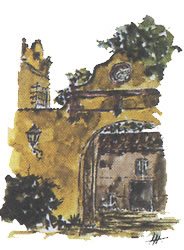Mannosidosis alpha (Alpha-Mannosidosis) - Gen MAN2B1.
Alpha mannosidosis is a rare inherited disease characterized by problems in many organs and tissues. Affected individuals may have mental retardation, characteristic facial features and skeletal abnormalities. Facial features may include a large head, prominent forehead, low hairline, rounded eyebrows, big ears, flattened bridge of the nose, protruding jaw, widely spaced teeth, gums too large and large tongue. Meanwhile, skeletal abnormalities characteristic of the disease may include osteopenia, bone thickening calvarial, deformation of the vertebrae, bowlegged or knock knees, and deterioration of the bones and joints. In addition, those affected may also have ataxia, myopathy, delayed development of motor skills, speech difficulties, increased risk of infections, hepatosplenomegaly, hydrocephalus, hearing loss and cataracts. Some affected individuals develop psychiatric symptoms such as depression, anxiety or hallucinations that may be triggered by stress factors such as operations, emotional distress, or changes in routine.
Signs and symptoms of the disease may vary from mild to severe. Alpha Mannosidosis may appear in childhood with rapid progression and severe neurological impairment. Often, people with this form of early onset not survive beyond infancy. In severe cases, an affected fetus may die before birth. Others have signs and symptoms that appear later, they progress more slowly and are milder. In these cases, they can live up to 50 years old. Milder cases can be detected only through laboratory tests and have few or no symptoms.
This process is due to mutations in the gene MAN2B1, located on the short arm of chromosome 19 (19p13.2). This gene encodes alpha-mannosidase enzyme, acting in lysosomes. In the lysosomes, the enzyme helps break down oligosaccharides attached to glycoproteins. In particular, the alpha-mannosidase helps break down oligosaccharides containing mannose.
They have identified more than 120 mutations in the gene MAN2B1 in people with alpha mannosidosis. Some of these mutations change the amino acid alpha-mannosidase enzyme. Other mutations result in a short enzyme or enzyme encoded incorrectly. These mutations interfere with the ability of the alpha-mannosidase enzyme to perform its role in the decomposition of oligosaccharides containing mannose. These oligosaccharides accumulate in lysosomes, causing a malfunction of cells eventually die. As a result, abnormal accumulation of oligosaccharides and cell death damaged tissues and organs, leading to the characteristic features of alpha mannosidosis.
This disease is inherited in an autosomal recessive pattern, that is, both copies of the gene in every cell must have mutations for alteration is expressed. The parents of an individual with an autosomal recessive disease have a copy of the mutated gene, but usually show no signs and symptoms of the disease.
Tests in IVAMI: in IVAMI perform detection of mutations associated with alpha mannosidosis, by complete PCR amplification of exons MAN2B1 gene, and subsequent sequencing.
Samples recommended: EDTA blood collected for separation of blood leukocytes, or impregnated sample card with dried blood (IVAMI may mail the card to deposit the blood sample).



